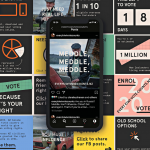It has been said that the traditional marketing funnel is ‘dead’ and marketers have to get used to the fact that they are trusted less than the customer referrals that are enabled by internet ratings and reviews.
Marketing Magazine managed to catch up with HubSpot’s Asia Pacific MD, Shahid Nizami, about this current train of thought in the marketplace.
It was quite interesting to note that he recently revealed that research by his company revealed that only 3 percent of people trusted marketers, which was quite a revelation.
Q: Can you elaborate on how marketers can stay relevant in a marketplace that will be based on customer referrals and word of mouth marketing etc?
A: To stay relevant, marketers need to start looking at the bigger picture and stop viewing the business as a funnel, and instead consider it as a flywheel.
That’s because the traditional funnel has one major flaw: it views customers as an afterthought, not a driving force.
Funnels produce customers but don’t consider how those customers can help you grow.
All of the energy you spent acquiring a customer is wasted at the bottom of the funnel, leaving you back at square one, having to use the same amount of energy again to acquire more of them.

The flywheel model solves that problem, by viewing your existing happy customers as potential advocates.
Whilst the flywheel may sound obscure, it is a much more efficient and effective way to think about growing a business.
To stay relevant, marketers should be taking responsibility for adding force and removing friction from their flywheel.
They should be reviewing the pre-sale customer journey, and looking for point of friction which are likely to cause frustration for the prospective customer.
That might be anything from the speed of the website, to ensuring live chat functionality is available for customers who don’t want to pick up the phone, or reviewing automated email nurturing to ensure everything works exactly as designed, and that these communications are actually helpful and valuable for prospective customers, vs. simply pushing them towards buying.

Q: Could you expand on the “customer obsessed rather than self obsessed” theme, in relation to how advertisers and marketers do their thing?
A: This comes from the HubSpot Customer Code, where we outline a set of principles and beliefs on how to build a company that customers love, based on the idea of becoming “customer obsessed rather than self obsessed”.
For a marketer, it’s really about pushing yourself to empathize with the customer in everything you work on.
Perhaps the most pertinent tenent of the Customer Code for marketers is “earn my attention, don’t steal it” — your time is precious, and so is your customer’s, so use your marketing materials to give them something they’ll value.
Rather than pestering them with ‘interruptive’ marketing tactics like impersonal email blasts using purchased lists, or flashing pop-ups pushing them to ‘buy now’, marketers need to think critically about what their buyer persona needs help with in relation to the solution being provided, and provide helpful content in the right place, at the right time, to move them along their journey towards becoming a customer in a really value-adding, personalized, and friction-less manner.

Q: In terms of the Malaysian marketplace for advertising, what’s your take on the industry right now?
A: Whilst out-of-home advertising is certainly still a high priority for Malaysian businesses, most are well aware of the need to combine this with digital marketing and advertising channels.
For example, we’re seeing Malaysian businesses like Speedhome — a home rental platform — use billboards to drive app downloads.
If done properly, pairing out-of-home and digital in this way can actually help measure the ROI on your out-of-home campaigns, which is traditionally difficult to do.
I think we’ll see this continue, and more and more businesses will prioritise connecting offline marketing with online in an attempt to get better insight into the channels and tactics that are driving real impact.
In a market like Malaysia, a one channel strategy will not suffice.

Q: Where do you see things going in terms of advertising trends for the country at the moment?
A: Malaysian businesses are demanding more insight into the ROI of their advertising and marketing.
Brand awareness and impressions don’t cut it anymore, as they don’t reflect true business impact, so marketers and advertisers in Malaysia are having to focus more on conversions and sales than they previously did.
And rightly so — it’s fine to run brand awareness campaigns, but these campaigns should be running alongside initiatives that contribute measurable revenue to the business via lead generation and sales.
Q: It is gratifying to see the kind of initiatives that HubSpot takes in terms of redefining how businesses see the customer and so on, do you think advertisers and marketers in Malaysia are receptive to these ideas?
A: As well as using our software, Malaysian businesses are very receptive to the inbound methodology HubSpot teaches for marketing, sales, and customer service.
Prior to the inbound methodology and HubSpot Academy’s free online courses that teach it, nobody was really helping Malaysian marketers learn this different way of doing things — that you don’t have to steal people’s attention in a way that’s ultimately damaging your brand, you need to attract their attention (and earn their trust) by providing value through your marketing.
It’s a much more effective and sustainable way of growing a business, as you end up creating a brand that people love by prioritising the customer experience.
When we talk about inbound marketing in Malaysia, or other countries like Thailand, Vietnam and India where a large proportion of marketing budget is still being spent on traditional advertising, we focus on helping businesses understand the importance of measuring the impact of out-of-home advertising by connecting it to their digital properties, and by focusing on achieving a measurable goal.
For example, is the goal of billboards in a particular city to increase website traffic from that city, or reach a certain number of app downloads from people in that area?
It’s not that out-of-home is ineffective, it’s just that it’s almost impossible to understand how effective it is without clear goal setting, and a digital component helping you to measure the impact.

Q: From your experience, with an increase in programmatic advertising, digital avenues and data-driven decisions being carried out in marketing, is branding losing its creative soul?
A: I think it makes brand marketing even more important. The marketing tech landscape has exploded over the years, and sophisticated tools are no longer only accessible to enterprise companies with big budgets.
Now, anybody can get started using free or very affordable tools like HubSpot’s free CRM, and start creating a sophisticated marketing strategy based on the data they’re collecting about their prospects on their website.
This democratization of marketing technology means that brand becomes a really important differentiator.
And by brand I don’t just mean your visual brand, but your brand values too.
It’s no longer about what you sell, it’s how you sell (and how you treat your customers) that sets you apart.
We often get feedback that our values really comes through in our brand marketing, in everything from our tone-of-voice to how we handle it when things go wrong — although we recognize we’re by no means perfect.
But we do often find that it’s one of the reasons our customers choose to work with us over our competitors — because they feel personally connected to our brand values.

Q: Finally, what are some key takeaways that you have seen so far in 2019 and moving on to 2020, how does the advertising marketplace look for you in terms of the APAC region?
A: It’s no secret that customer acquisition costs (CAC) have been steadily rising for B2B and B2C companies.
Most businesses focus on lowering CAC, and inbound marketing made this pretty easy, but it’s getting harder as the likes of Facebook and Google make it harder to acquire customers without large advertising budgets to supplement your organic strategy.
Whilst businesses in APAC should absolutely still focus on building an inbound marketing machine, and supplementing organic acquisition with paid advertising where necessary, the truth is that acquisition costs are likely to continue rising.
To avoid getting outrun by competitors with bigger budgets, the biggest untapped acquisition channel is your existing happy customers.
If you simply view customers as an output of your marketing efforts, rather than a potential input, all of the energy you spent acquiring a customer is wasted, leaving you back at square one, having to use the same amount of time and budget again to acquire more of them.
Companies in APAC that understand the influence of their existing customers in their growth trajectory will grow better (and be more likely to succeed in the long run) than those who view their customers simply as an output of their marketing and sales initiatives.
They will make different decisions — ones that are better for the customer experience — and as a result, those customers become advocates who have a huge amount of influence over a business’ future success.
MARKETING Magazine is not responsible for the content of external sites.










Comments are closed.